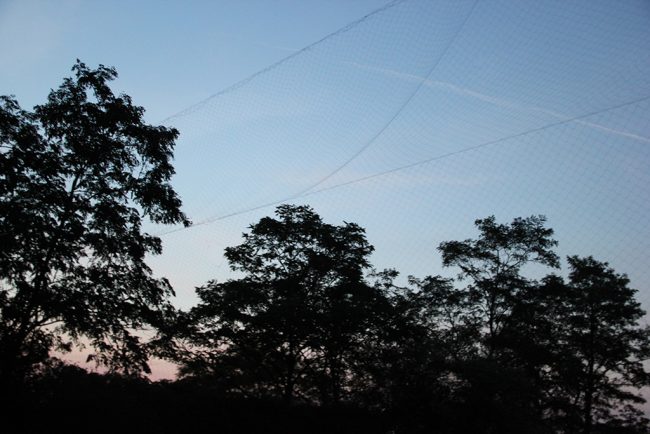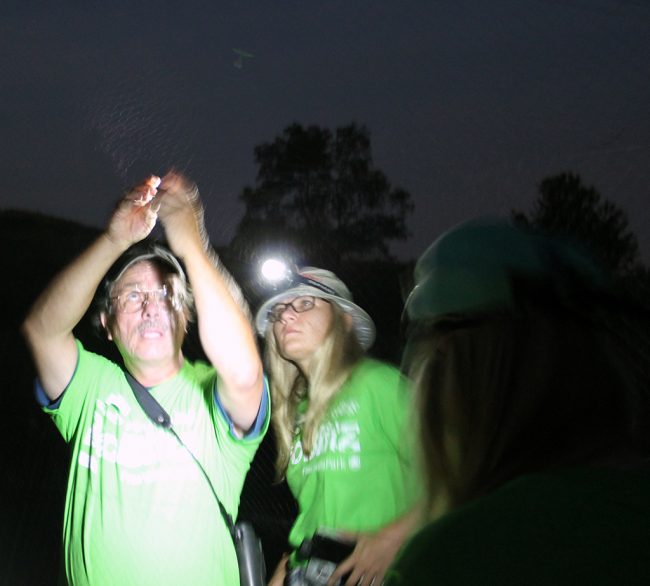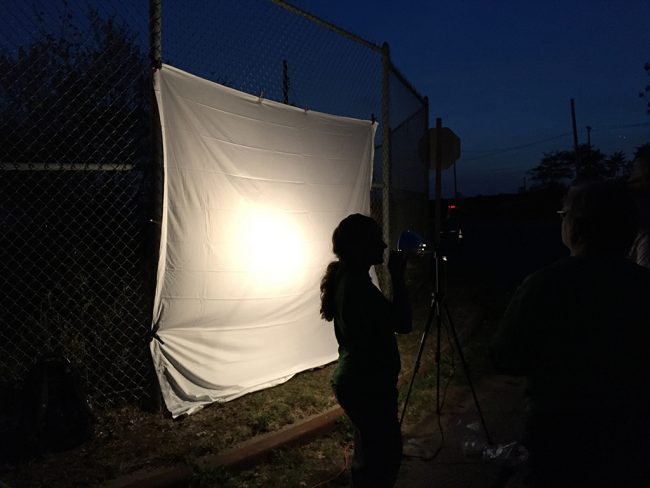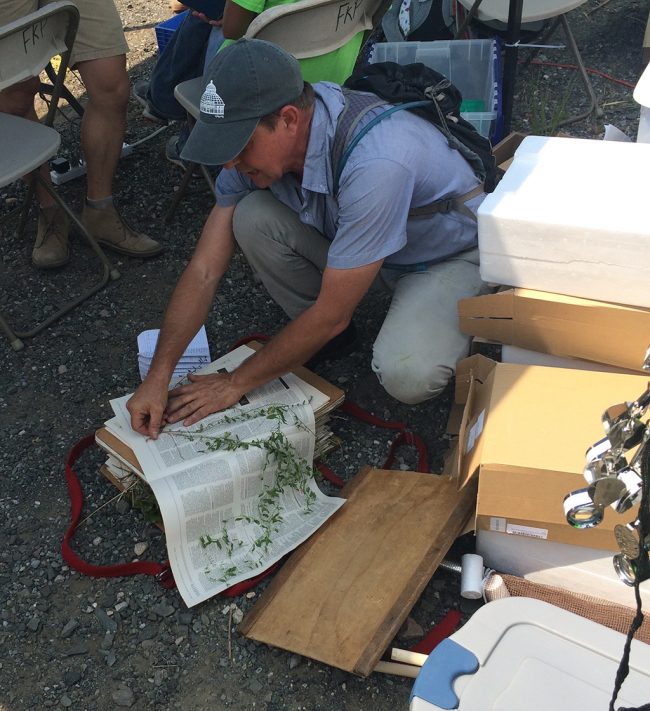
We are celebrating 15 years — and counting — of stories that are deeply researched and deeply felt, that build a historical record of what the city has been.
We are celebrating 15 years — and counting — of stories that are deeply researched and deeply felt, that build a historical record of what the city has been.
Staten Island’s Freshkills, once the world’s largest landfill and now in the midst of a decades-long transformation into one of the city’s largest public parks, is a special beast. But the dramatic landfill-to-park metamorphosis, in which former trash piles have given way to bucolic, grassy mounds, is only part of its allure. For the scientific community, it also presents a rare opportunity to observe and promote an ecological system’s healing after a fundamental disruption of what was once, in this case, a warren of teeming tidal creeks and coastal marshland.
The Freshkills Park Alliance has for years opened the site to scientific inquiry, with the dual purpose of informing plans for restoration and allowing scientists to further their own research. Keen to meet some of those working at Freshkills and to see how the biodiversity of the area has rebounded, five writers took part in a 24-hour survey of flora and fauna at the end of August. This BioBlitz, put on by the Alliance and CUNY’s Macaulay Honors College, followed a formula embraced by land managers, biologists, and interested citizen-scientists across the world. Over the course of our few-hour shifts, each of us joined a different team and focused on bats, nocturnal insects, damsel- and dragonflies, various plants, and moss. Here we bring you five dispatches from the field — and many other niches within the park — to illustrate not only what has returned to this place but also how we meddling humans go about finding and assessing it. –J.T.

A mist net lies in wait for unsuspecting bats in Freshkills Park at dusk. | Photo by Jonathan Tarleton
Until I arrived on the dark stretch of road pinned in by the North Mound and the West Shore Expressway, I didn’t know what bat collection entailed. The occasion for my nighttime excursion to Freshkills Park was the BioBlitz, a 24-hour citizen science survey of the park, lead in part by the many scientists at work in the former landfill, to document all manner of living thing, from damselflies to moss, camphor to scarab beetles.
The bat team is a plush gig if you yearn for nighttime wanderings in a publicly inaccessible, wide-open anomaly like Freshkills. On top of the scientists who led each team, my partners in survey were students from CUNY’s Macaulay Honors College with varying degrees of appreciation that an evening on Staten Island’s most notorious grounds was quite a privilege.
No matter. Danielle Fibikar, a graduate student at the College of Staten Island studying bats, and Dr. Richard Veit, a bird expert and Fibikar’s advisor, soon got to business. A first sweep of the five mist nets stretched across the park road delivered no bats and, thanks to our leaders’ frequent warnings, no unwittingly entangled participants either. About twelve feet tall and fine enough that they are nearly invisible in daylight, the nets are crude if effective technology: bats fly into them and fall into small folds in the netting, where they stay until the researcher arrives.

Dr. Richard Veit and Danielle Fibikar extricate a scarab beetle from a mist net. | Photo by Jonathan Tarleton
In catching her beloved flying mammals, Fibikar was out to determine something of great interest in the bat community: whether white nose fungus, the killer of nearly 90 percent of the little brown bat population in recent years and a mortal danger to other varieties as well, had crept into Freshkills. After three years of research — many nights a week spent in her car waiting to check the nets, a scene reminiscent of a teenager sneaking a smoke — she’d yet to find any evidence of the fungal culprit among the park’s bats, which are primarily common red and big brown visitors. Bats don’t call Freshkills home; they’re migrants on the trail of their seasonal food source and winter hibernation stations.
I had bragged to friends about my impending bevy of bats, but after the second net check turned up empty, Fibikar came clean: following a bounty of 75 the year prior, 2015 had only brought her five bats, more a function of less time in the field than a decrease in population. The black shapes swooping overhead attested to their presence, their high-frequency chirps mapping the surroundings for these nearly blind creatures with exceptional spatial awareness.
I felt the thrill, now far more intimate, of their wayfinding reaching my humble ears.
With the student crew eager for more bat contact, our team set out onto the nearby mound, bat vocalization detectors in hand. Anabats, as the detectors are called, look like the kind of high-tech handheld audio recorder you’d use for an oral history interview. The resemblance is fitting; they make the bats heard by taking in environmental sound and radioing it out at frequencies audible to humans. As we plotted a route through the grasslands, the silhouette of a deer’s antlers stood out before the full moon, and a rabbit scampered by. The group hardly noticed, glued to our two Anabats, waiting for chirps. As we entered a corridor of trees, the singing picked up, eight calls counted in total. The nets still empty, we settled for our airborne specimens and their locative voices.
I silently thanked each bat for the 500+ mosquitoes it had likely eaten in the hour since we arrived. Even with the dull buzz of the interstate at my back, the scene was idyllic. Off by myself, I picked up an Anabat for the first time and felt the thrill, now far more intimate, of their wayfinding reaching my humble ears.

A light trap, consisting of a white sheet and a light on a tripod, attracts nocturnal insects. | Photo by Emily Schmidt
A light trap powered by a mercury vapor lamp and fifteen aspirators, all cast in the dim silvery light of a full moon hanging low in the sky. This equipment wasn’t for completing a sterile surgical procedure but for capturing small, live insects in the field. I had never thought about how researchers managed this, but it’s appealingly simple, if at first cringe inducing.
The light trap consisted of a white sheet, stretched across a chain-link fence and fastened with clothespins, and a small lamp on a tripod that lit the surface from a few feet away. The aspirators were small glass vials capped by a rubber stopper with two pipes — one small, bent metal tube and a longer flexible rubber one — protruding from the top. The operation is powered by human breath: to capture the insects attracted to the trap, you suck them into the aspirator vial. Positioning the end of the metal tube lightly on the sheet and inhaling through the rubber tube traps the bug inside the glass, unscathed.
This insect-catching technique was taught by team leaders Professor Amy Berkov, graduate student Jhunior Morillo, and other students from Berkov’s tropical ecology lab at City College, home to their research on wood-boring beetles. That sounded like an awfully specific field until Berkov casually mentioned that one in four known animal species is a beetle. Color me surprised.
As we collected crepuscular (that is, nocturnal) insects, “drawn like a moth to a flame” was literally in action. The first catch was a Diptera (an order meaning “two wings”), a common midge. Other Diptera, Hemiptera, and Lepidoptera quickly followed: ladybugs (properly known as ladybird beetles), mosquitos, stinkbugs, moths, and a scarab beetle. The light trap lured the participating students as well — they crowded the trap, rubber tubes in mouths, poised to gather the next unsuspecting specimen to land on the sheet. I became acutely aware of the chatter of crickets and katydids, the soundtrack to summer nights, which melded with the noise of the generator powering the lamp into a constant background hum.
A student replicated what I assumed was a routine for Saturday nights not spent collecting bugs by cracking open a Red Bull at half past eight. Nearby, one particularly eager trapper named his catches: Jeff, Arthur, Brian, Pillsbury, and — his favorite — Nathaniel. Yet he didn’t have much trouble tipping his new friends into the flask of clear alcohol, crowding it with the dark bodies of dead bugs.
Captures were logged on a data sheet as they were put down the watery chamber. Moths were treated differently, sealed in glassine envelopes, then squish, flattened between thumb and index finger with care to preserve the wings. The specimens would be brought back to the lab for identification under a microscope; even for experts it’s very hard to distinguish species in the field. “I think you’re overdiagnosing mosquitoes,” Berkov told the team.
The insects landing on the sheet were sparse. In a productive area of the tropics, where Berkov normally works, the full sheet would be covered. Yet for a place whose sole purpose for more than six decades was to swallow and hide everything that humans deemed unwanted, the growing diversity of insect life at Freshkills is striking. The park demonstrates nature’s remarkable ability to heal, helped along in this case by its former abusers — New Yorkers whose trash once soiled the landscape are now dedicated to nurturing it back into a healthy habitat. This place provides a unique baseline in that regard; as Berkov put it, “What comes back when you’re starting from nothing?”
“Odonata,” the Greek name of the family of insects that encompasses damsel- and dragonflies, translates to “the toothed one.” That these two relatives have teeth at all — let alone what a damselfly is — was news to my group. Gathered in a parking lot, team leader Seth Wollney expressed disappointed with our lack of knowledge and preparation.
“Damselflies are smaller, weaker dragonflies — you know, hence the damsel.”
“That’s some gendered taxonomy,” a young woman quickly replied — unprepared, maybe, but sharp. She would go on to debate the advisability of bringing a date to the wetlands of Staten Island. Her conclusion: more cons than pros. Wollney did not agree.
A self-described Dead Head with the tattoos, bumper stickers, and visor to prove it, Wollney is in the third year of his Ph.D. at the College of Staten Island, where he studies turtles on the Island and in the Catskills. Specifically, he is sequencing their DNA to better understand biodiversity in New York City ponds. He is also an exceptional frog caller (demonstrably so) and the record holder for most bird species spotted in New Hampshire in the month of January. Not a bird would pass without being named for the rest of our trip.
Dennis Paulson — our other, much quieter guide — described himself as a volunteer with a day job, belying his knowledge and commitment to Freshkills. Paulson and Wollney are nine years into an impressive ecological survey of the park’s dragonfly and damselfly species for the City’s Parks Department. Their goal is to document the increasing biodiversity of Freshkills as the area moves beyond its landfill past. Thus far, they have counted some 45 species of dragons and 33 of damsels in its reaches. If my time with the two guides is any testament, they are able to recognize and name every type with little hesitation.
Paulson, Wollney, and the Parks Department’s interest in dragon- and damselflies arises from their role as key bioindicators. While many common varieties — like Familiar Bluets and Eastern Forktales — do just fine in extremely damaged ecosystems, many of their Odonata kin do not. And since these varieties are often some of the first animals to return to ecosystems on the mend, their presence is a key to understanding how Freshkills is recuperating from its garbage dump days.
A couple hours watching these frantic fliers was mesmerizing and, with easy access to Wollney and Paulson’s encyclopedic knowledge, satisfying.
We caught a few of the bugs in nets as we walked along the road. Thanks to Wollney and Paulson’s ability to handle the creatures without hurting them, we observed up close some of the differences between dragonflies — their wings fold out when at rest — and damselflies, whose wings lift up.
Hundreds gathered on the edges of the nearby ponds. But according to our experts, this was still a light day. In some areas they sat upon sticks, grouping in fives, tens, and twenties. Some were big enough to spot from 40 feet away as they crossed the blue water.
It’s not uncommon for males and females of dragon- and damselfly varieties to be completely different sizes, colors, and shapes. Their colors are, however, uniformly bright. As they flew, I began to notice patterns among the different species — how high they reached, which ones were mating, and the way they grouped on specific sticks across the water. A couple hours watching these frantic fliers was mesmerizing and, with easy access to Wollney and Paulson’s encyclopedic knowledge, satisfying.
As we crossed a bridge, the students asked after the providence of a white pipe to the east, a few dozen feet of the 170,000 related to methane and leachate collection in the park. Freshkills’ palpable expanse is still not so big as to fully hide such evidence of the huge physical, technological, and political efforts needed to transform it from landfill to parkland. But even this seemingly immodest intruder in the otherwise picturesque grassland appeared to be of little interest to our guides. Wollney, a man who could spot a quarter-inch-long damselfly from a mile away, looked as if he’d never noticed it: “Oh that? I guess it’s for the methane.”
Plant collecting hasn’t changed much since Swedish botanist Carl Linnaeus, the father of modern taxonomy, gathered and classified flora for his herbarium 300 years ago. You begin by extracting a plant from the ground, assigning it a number, and recording details about its location and environmental conditions. Then, you spread the specimen out between newspaper and cardboard before compressing it between a pair of wooden planks bound by a belt or set of screws. As you collect, the plants begin to stack up like books on a library shelf. It’s a fitting simile — each specimen has stories to tell.
It was uplifting to see — even on a tiny scale — human infrastructure promoting biodiversity rather than eliminating it.
Breaking down these tales was Donald McClelland, a professor at Baruch College and expert on Solanum, the plant genus that includes potatoes, tomatoes, eggplants, and other nightshades. He proved a passionate biologist, occasionally darting off into the thick brush to bring back an interesting flower for closer examination. Hearing him discuss his thesis, “Systematics and Taxonomy of Solanum Section Dunaliana and Section Irenosolanum (Solanaceae),” you would wonder why people study anything else.
I expected McClelland would have us bushwhacking deep into the grasslands to specimen havens safeguarded from plucking and trampling. To my surprise, the greatest variety of plant life existed at the perimeter of the parking lot, feet from our bus. There for the next two hours we studied a surprising array, from carrots to legumes, Russian olives to Bradford pears. We passed camphor flowers used for flavoring gin, dogbane for making rope, and inkberry, used to write the US Constitution. While we didn’t capture our own specimens, we used magnifying glasses to note subtle distinctions between different flowers and shrubs: the varying number, shape, size, and color of leaves and petals. The floral heads of daisies transformed under the microscope from what originally looked like singular masses to clusters of hundreds of smaller flowers. We could see the hooked spines of cockleburs that attach to clothes and allow for seed dispersal.

Daniel Atha from the New York Botanical Garden demonstrates plant pressing technique. | Photo by Wyatt Cmar
The parking lot may not seem like the likeliest setting for vegetative richness, but areas of moderate disturbance often exhibit high levels of diversity. The transition from wet ground to concrete means greater nutrient variation in the soil, and the barriers and telephone poles that line the parking lot keep a constant supply of seed-pooping birds at hand. It was uplifting to see — even on a tiny scale — human infrastructure promoting biodiversity rather than eliminating it. We also passed invasive species like the abundant European strain of the common reed that has all but wiped out its American counterpart. In attempts to create diversity, disregard for distinctions between what is native and what is introduced — a kind of amnesia to McClelland — can just as easily have the opposite effect.
The ecological restoration work ongoing at Freshkills, a human-nature joint endeavor, is still an experiment, necessitating expeditions like the BioBlitz to see to it that our interventions are truly working. But the samples and data collected will also be reviewed on a grander scale. Alongside Linnaeus’ records, they tell the story of plant lineage — which ones thrived, which ones perished, and why.
With leaves only one cell thick, moss is too delicate to fossilize. But, centuries of human use make evident moss’s strength. It has been repurposed as diapers, menstrual pads, bedding, and boot liners. WWI trench soldiers applied the dried plant’s antiseptic properties to clean hemorrhaging wounds. Shipbuilders in the British Isles used moss for millennia to seal their hulls from the northern seas. These uses have waned over the past century, leaving a lack of evidence in daily life akin to moss’s poor showing in the fossil record.
Moss also appears to be absent in Freshkills Park.
“Or, maybe it’s hiding!”
Ana, a second-year college student, raises our hope for discovery. Surely, she thinks, moss grows in these hills, never mind the noxious bedrock of metal, plastic, toys, unused gift cards, and rot. From our vantage point, atop sixty years of deposited trash unrolls a new, earthy surface punctured with enough off-gassing equipment to deliver a public park by 2035.
It’s beautiful here. A tidal river cuts inland toward a horizon made soft by phragmites, an invasive grass. Broken floor tiles and a nicotine patch rub through the dirt against my feet. The air is salty. I wonder how far I must dig before I pierce the thick plastic sheets that contain this cruddy ground.
Our group spends much of the afternoon shepherded through fields, forests, and trails looking for moss. Along the way, we identify sumac, cherry trees, butterflies, and ant lions. A guide captures a praying mantis in her hands.
“We’ve become the group of miscellaneous specimens!” Ana smiles before pushing through a hedge that rings a suspected moss den. She is careful to avoid a wellhead while turning to show the group her latest discovery: a winged queen ant scurrying across a branch.
We seek … a more intense sense of the here and now, the beauty and value of the world we live in. — Oliver Sacks
Raised on Staten Island, Ana enrolled in CUNY’s Macaulay Honors College program in Brooklyn. On school days, she takes the ferry across the harbor to Lower Manhattan before riding the subway under the East River to campus, a two-hour trip from home. “The travel is worth it,” she said. “I love my classes and I meet students of all different types of backgrounds: Puerto Rican, Hasidic…” her voice trails off as she points to Elisabeth.
“I’m not Hasidic,” Elisabeth clarified, pulling her long black skirt.
Nearby, we find our target covering a tree stump. This ancient species is not parasitic: moss seeks out amenable conditions like the shade of this tree, living independently from the nutrients and plant life around it.
I think of scientist and writer Oliver Sacks, who died that morning only a few miles from here. In this incipient park that blooms above trash, resettling an old landscape for a new future, Sacks’ words come to mind: “We may seek … transports that make our consciousness of time and mortality easier to bear. We seek a holiday from our inner and outer restrictions, a more intense sense of the here and now, the beauty and value of the world we live in.”
Elisabeth completes a cartwheel. A young couple joins hands. Moss creeps in through the shade.
The views expressed here are those of the authors only and do not reflect the position of The Architectural League of New York.